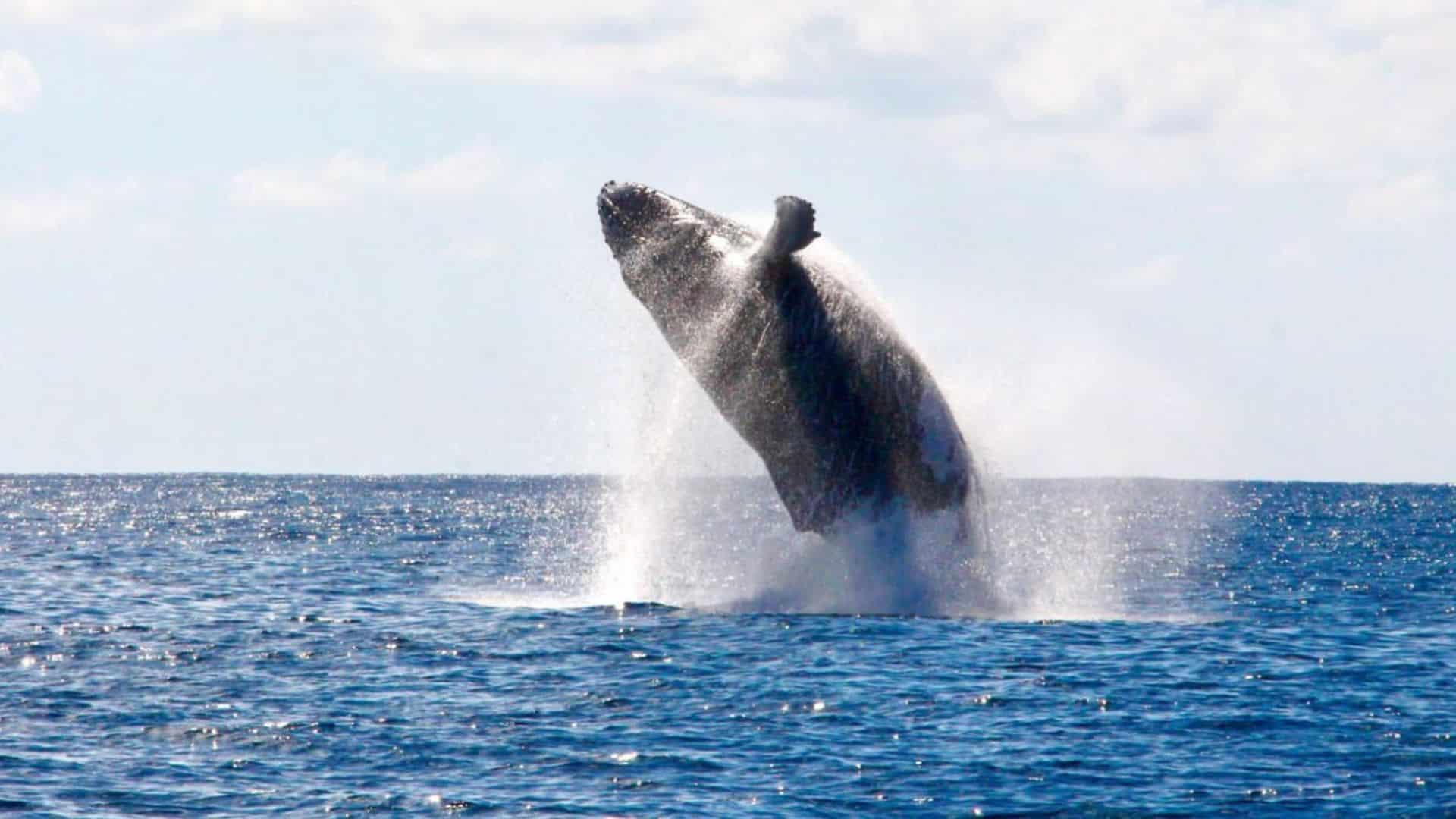Lots of people watch whales. But telling males and females apart and one whale from another takes special expertise. One researcher is using AI to do that.

A whale leaps out of the water. Credit: Josianne Bouffard
This article, by high school student Keya Dutt, was produced out of News Decoder’s school partnership program. Over the past year, Keya was a student at School Year Abroad, a News Decoder partner institution. Learn more about how News Decoder can work with your school.
This story won an honorable mention in News Decoder’s 14th Storytelling Contest.
Off the beach of Tofo, Mozambique, Livia Gavard snorkeled through the Indian Ocean, watching a group of dolphins swimming just underneath her.
Most of her group had gone up ahead, watching the other dolphins. Seeing something out of the corner of her eye, Gavard turned her head to the right, making direct eye contact with a baby humpback whale swimming in the water next to her.
Looking down, Gavard saw another humpback whale, this time three times the size of the one swimming at the surface with her.
“I will never forget when that baby whale looked at me, and I wasn’t sure who was looking at who,” Gavard said. “The whale kind of felt more curious about me than I felt about him.”
Gavard has always loved the ocean, but her interest in whales started with a class trip to the south of Spain when she was 16.
“And that’s when I realized,” Gavard said, “that being on a boat, taking pictures of whales and dolphins was where I wanted to be in life.”
Identifying individual whales
Gavard is about to start her last year as a veterinary student. In Tofo, she hopes to find an exact population estimate of the humpback whales.
Each year from October to May, humpback whales in Mozambique travel south to Antarctica to feed and rest for the upcoming mating season. From June to September, the whales make their way north, around the southern and eastern coasts of Africa.
Here, pregnant females give birth to newborn whales, as the waters in Antarctica are too cold for them, while the other female whales will look for male partners to mate with.
Using artificial intelligence to tell humpbacks apart
Gavard has spent each winter for the past six years in Tofo, identifying whales using photos of the whales’ flukes. Whale flukes, found on the underside of the tail fin, are a series of scars in a pattern of black and white.
They are accumulated over the course of a whale’s life, and each are in a shape that is unique to the individual whale. After gathering pictures of the whales’ flukes, Gavard returns from the boat and puts the pictures through an AI known as ‘flukebook’.
“It effectively works like a fingerprint,” Gavard said. Once a whale’s fluke is photographed and uploaded onto the website, it will be recognized if another picture of its fluke is ever uploaded onto the site again.
It has not always been this easy for humpback whale researchers.
Before flukebook gained popularity, the main method of whale identification was visual matching, where a researcher would manually look through and match the flukes to one another.
“It was really labor intensive though, and it drives you a bit crazy,” said Gavard. “You get a bit cross-eyed after looking at too many.”
Mapping out the whale fluke
Gavard’s master’s project is focused on identifying a connection between different types of scars and their locations on the fluke, as well as a correlation between scarring and the sex of the whale. For this purpose, Gavard uses another AI system to map out the fluke into different sectors. She then writes down what types of scars are found in specific sectors of the fluke.
Gavard’s research might also help in identifying the sex of a humpback whale. Right now, this is difficult without a tissue sample because they have almost no sexual dimorphism. That’s when the males and females look different because of a difference in color, size, shape or other factors.
“You can tell a rooster from a hen just by looking at them because they look different,” Gavard said. “In whales you don’t have that. The females grow a bit larger than the males, but when you’re out there on the boat you can’t really use that to identify anything.”
Researchers have used individual and group behavior to identify the sex of whales in the past. And previous research has shown that there is a connection between the amount of scars on a whale’s back and their sex, so Gavard is hopeful that there will be a similar connection with the scarring on the flukes.
“But it’s like everything in science,” Gavard said. “I might be completely wrong, but I’ll only find out after I do the work.”
First, find some whales.
Gavard’s research process starts with going offshore to search for whales. Generally, when the whales come to the surface to breathe, they will dive down a bit deeper into the water after taking their last breath. Sometimes they will flash their flukes during this, allowing anyone in the right place to take a picture of the underside of their tails.
Some experience is required in this process. Gavard will choose certain groups of whales that she thinks are more likely to flash their flukes over other groups, choosing to follow and observe their behavior while simultaneously trying to identify who she thinks might be male or female in the group.
Gavard does have one difference compared to most other humpback whale researchers. While most researchers come from a marine biology background, Gavard has certain advantages and disadvantages from coming from a veterinarian background.
“As veterinarians, we are trained to see things from a different perspective than marine biologists,” Gavard said. “Oftentimes we will look at the same whale and my takeaway might be that it has a scar in a certain spot or is behaving a certain way, while my marine biologist colleagues will put it into the context of tides and currents.”
A marine biologist might get a much better understanding of sea ecology, for example, how currents work or how coral reefs sustain themselves, while a vet might get a much better understanding of the physiology of each individual in the ocean.
“It’s been very interesting to combine skill sets with marine biologists to get a more complete view of what’s in front of us,” Gavard said. “Vets have a much more individualistic view on organisms rather than population studies. A better understanding of diseases, anatomy, basically looking at each organism individually.”
Gavard plans to move to Tofo permanently after graduating from veterinary school to continue the research on humpback whales. She would like to combine her work as a veterinarian and her work with humpbacks. Eventually, she would like to do a GPS study on the whales. This includes putting satellite tags on the whales and tracking their movements throughout their lifetimes.
“Then there’s also the fact that I kind of almost happened on this, by chance,” Gavard said. “After that class trip in Spain almost 10 years ago now.”
questions to consider:
- What makes identifying whales difficult?
- Why do humpback whales migrate?
- If you could spend your life studying one particular animal, what would you study and why?

Keya Dutt is from Chicago, Illinois, and spent the last year studying at School Year Abroad Italy. In the United States, she attends the Latin School of Chicago. She has lived in Chicago, Tokyo, Detroit, Hyderabad, Shanghai and Perth. Her favorite subject is History, and outside of class she enjoys Model United Nations. In the future, she hopes to major in History or English at university and eventually become a political journalist.

if someone put a thing in your body for whole life. you will like it ?